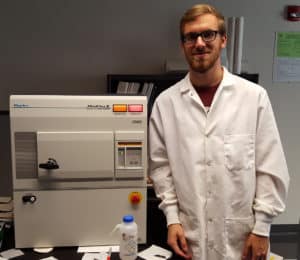
Solar Cells & Scottish Culture
Over the summer, two separate teams of SMC faculty and students participated in grant-funded research projects. Adam Siegfried, Professor of Chemistry, along with sophomores Bret McAbee and Austin Miller, won a $5,000 Furman University Research Experiences for Undergraduates Program grant to study how solar cells can be improved and used to convert sunlight into electricity. Their research, conducted primarily at Furman, began after the students’ graduation from SMC in May and ended in late July.
Dr. Cole Cheek, Professor of History, and sophomore Emily Edmonds secured an $800 SCICU (South Carolina Independent Colleges and Universities) research grant to cover the cost of travel associated with conducting original historical research.
Speeding Up Solar Cells
Siegfried’s team set out to increase the efficiency (or energy output) of solar cells by speeding up the movement of iodine atoms within the cells (a phenomenon known as “iodine hopping”), or slowing or stopping movement of fluorescent molecules in the cell’s electrolyte fluid.

Miller focused on building a completely new iodine crystal in the lab. If the new microscopic crystals increased the rate of iodine hopping, the cells would produce more energy – an innovation that could help bring better solar cells to the energy market.
“We were able to see the iodine-containing molecules using the X-ray diffractometer at Clemson University,” said Miller. “The imaging shows the three-dimensional structure of the molecules. From this structure we can predict properties and its potential usefulness in dye-sensitized solar cells.”
McAbee’s project focused on trying to cause a fluorescent molecule to become motionless instead of constantly moving. The constant movement gives off heat, but if the molecule were stopped, it would give off light instead. These “lit” molecules could then be used to identify possibly poisonous, colorless substances (such as fluorine, bromine and iodine) in everyday consumer items.

“I was able to successfully make part of the molecules for the project, but it needs more time to work out the final synthetic steps,” said McAbee. “The summer was successful in that the project started off well. The final reactions are difficult and require further study for them to be successful, so it’s a work in progress.”
Professor Siegfried supervised the research, which will be published in the spring.
“Bret and Austin were great,” said Siegfried. “They were motivated and interested in the work. They had a genuine curiosity, and they learned a lot of new things.” For Miller and McAbee, the research was also an eye-opening introduction to the world of scientific research as a potential career field.
“This experience gave me more confidence in my academic future by giving me experience I need to be successful,” said Miller.
“It also allowed me to appreciate chemistry on a much higher level while also exposing me to the many outlets a career in chemistry can have.”
McAbee, who began the project planning to become a medical doctor or researcher, had a real-life realization that he couldn’t ignore. “It made me realize I do not like lab work,” chuckled McAbee. “I changed my major to my best subject, mathematics. I plan to be a mathematics professor when I complete my schooling, so it was better to realize that now than later.”
Miller is currently studying at the University of South Carolina-Columbia, majoring in exercise science. McAbee is studying at Presbyterian College majoring in mathematics.
Focusing on Scottish Culture
For the SCICU grant, Dr. Cheek and Edmonds discussed ideas and, after some pivots in the angle, focused on how the Scots-Irish heritage impacted the Appalachian culture.
“I really wanted to study the history of linguistics in Appalachia history,” said Edmonds. “I believe it has very close ties to the Scottish-Irish culture that arrived in the 1700s-1800s. However, I wasn’t able to find enough supporting materials to continue that angle and decided upon the overall influence of the Scots-Irish heritage on the people of Appalachia.”

Dr. Cheek supervised the research and learned more from Edmonds than he anticipated. “I don’t know much about linguistics or the Scottish-Irish heritage, so although I could help with the process, she was the one to find the information and put the historical pieces together. I learned a lot through her process,” he said. Edmonds appreciated the experience and looks forward to presenting her paper at a SCICU conference in February 2017.
“This experience has solidified my love and interest in history,” said Edmonds. “The project is going to help me from a resume perspective as I begin applying for college and graduate school in order to pursue my history degree.”
